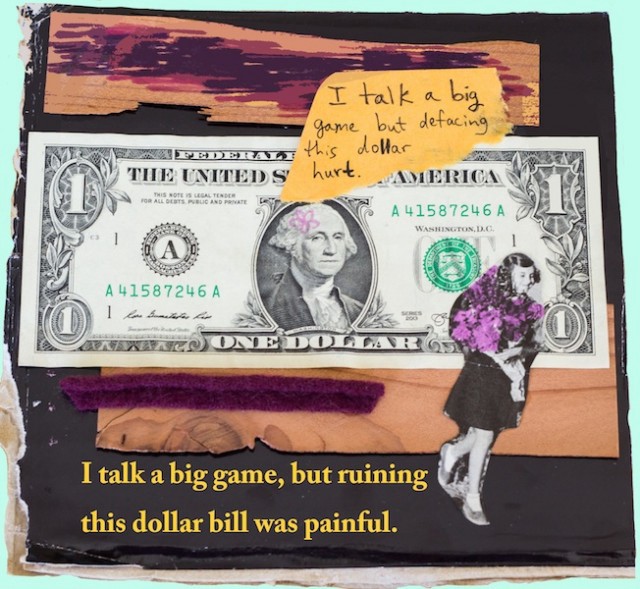Artisanal Dollars
by Sonya Mann

Illo by the author, Sonya Mann
When I have cash, I spend it like water. The floppy pieces of linen-paper don’t feel like real money. Real money is the number displayed in my bank account online.
I can’t take dollars seriously, but they do have substance, even redolence. Every time I mention that I love the scent of cash, someone points out how filthy money is. Can’t argue with that — whatever passes through hundreds of hands is dirty. I laugh and say, “Mmm, cocaine residue!” I read a statistic once that claimed some large percentage of dollars have drug traces on them.
According to the Federal Reserve website, currency notes last four to fifteen years, depending on the denomination. The mean average is almost seven years, and the median is roughly five and a half. Money endures about as long as a pet. The internet, as we are earnestly reminded by anti-sexting crusaders, is forever.
Cash is physical but it’s ephemeral. Easy come, easy go. I do try to be strategic in terms of the effect of my spending. I use my debit card at big businesses, like Starbucks or Target, and save the crumpled dollars for independent establishments, to spare them the processing fees. Often I can’t do this though because I don’t have cash at all. Who goes to the ATM these days? I scan checks using the Bank of America app on my phone — but I rarely receive checks. It’s all PayPal or direct deposit.
Money, on paper? What is this, the ’40s?
Occasionally twenties enter my wallet after cash back from Safeway. Usually when I have paper money it’s because the bills were pressed into my hand by a neighbor. For instance, last week I drove a lady to and from the train station. Her car registration sticker was late in the mail, and she didn’t want to risk getting another ticket. She paid me $10 per day. One time in singles! That was a novelty.
I feel like cash is money already spent. After all, it never factors into my bank account balance. The seeming insignificance of paper dollars leads me to dole them out generously, perhaps beyond my own best interest. I treat my boyfriend instead of going Dutch, tip heavily at cafes, and drop money into street musicians’ hats. Later I look at my checking account and feel anxiously broke. But I don’t think, “Where did all the money go?!” I never felt like I had it.
Granted, I am somewhat profligate with my regular money as well. I do things like donate to an editorial website that I’ve only visited like five times and buy everything that the rap band Clipping has released even though most of their music is on SoundCloud. Those are exceptions, not the rule. Mostly I’m pretty stingy, but my Internet Person Who Makes Things solidarity is strong.
I’m writing a sci-fi story about how the “real” world has moved from the physical domain to the virtual one. We participate in smartphone social media all day. Websites and apps are the primary “places” where we create and negotiate our lives’ meaning. What’s the secret of happiness? No, don’t Google it. Pose the existential query to your friends on Snapchat. The dubious impermanence makes a point. This dynamic isn’t totally true yet, but it’s the future I see from here. Think about your relationship to Facebook! It’s almost as important as your relationships on Facebook.
In my story, everyone is plugged into various matrices, living the Oculus Rift equivalent of Second Life. Huge companies perpetrate massive data collection and storage, neither for good nor evil but for profits. I type it all on a computer; the file is triple-saved on my hard drive, Google Drive, and Backblaze. My manuscript physically exists, but not in a way that I can comprehend. To me, it’s an icon in a folder, which is signified by another icon displayed on a screen. How is the information preserved? Beats me.
If I pried my laptop open to look at the motherboard or whatever it is, that would not illuminate anything. I’d prop my hands on my hips and say, “Huh, those are some shiny metal doohickeys.” The innards of a computer don’t embody any common-sense, cause-and-effect relationships.
The world used to be like baseball: you watched the pitcher throw the ball, you saw and heard when it connected with the bat, and you visually traced the ball’s trajectory until an outfielder snatched it from the air. Applause roared in the stands because everybody knew what the heck was going on. For that matter, when you bought tickets to attend the game, you and the cashier exchanged tokens of value that you could hold in your hands. Now you flash a QR code on your phone before breezing into the stadium. The phone sits in your pocket, but the QR code doesn’t, at least not in any way that makes concrete, touchable sense.
I don’t think this is a bad thing. Conducting financial interactions online is ludicrously more convenient than the analog options. But the shift is strange. Depending on how you look at it, a digital dollar is single-use, generated for one specific transaction, or infinite-use, a snippet of code passed from commercial entity to commercial entity, tied to the info-profile of whoever “owns” it at the moment.
Nowadays money doesn’t have physical lifespan. It doesn’t have a smell and cocaine residue can’t cling to it. This exemplifies the weird digital remaking of reality in which most of us enthusiastically participate.
Sonya is a Millennial who likes to write about selling stuff to other Millennials. Also her feelings.
Support The Billfold
The Billfold continues to exist thanks to support from our readers. Help us continue to do our work by making a monthly pledge on Patreon or a one-time-only contribution through PayPal.
Comments